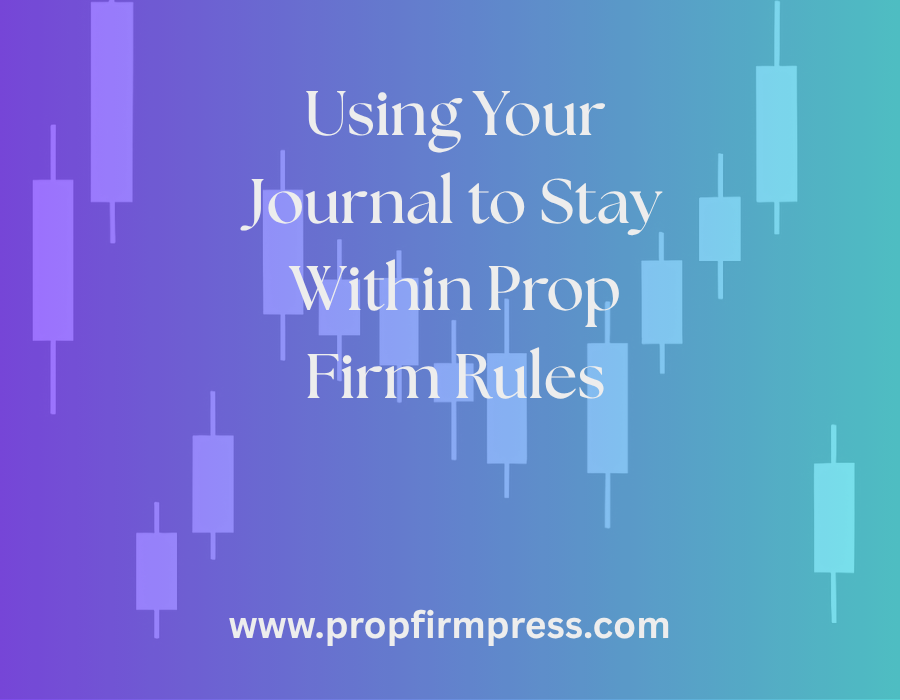Using Your Journal to Stay Within Prop Firm Rules
Most traders think of journals as a place to log trades, but when used properly, they become a strategic tool to stay compliant with proprietary trading firm rules. With prop firms like Bulenox, Funded Futures Network, or Instant Funding, one small violation can end your challenge or funded account. A well-designed journal keeps you from making costly errors by tracking rule adherence in real-time.
Why Compliance is Critical for Funded Traders
Prop firm evaluations have specific rule sets: max daily drawdown, maximum lot size, profit targets, restricted instruments, and even required trading days. Break any of these, and you’re often forced to reset or lose your account. Journaling for compliance helps you self-regulate before the firm intervenes.
Common Rules to Track in a Journal
- Daily Loss Limit: Were you close to breaching it?
- Max Position Size: Did your trade exceed size rules?
- Holding Overnight: Did you close trades in time?
- Required Days: Are you meeting the minimum active trading days?
- Trailing vs Static Drawdown: Are you aware of the current buffer?
By creating a checklist or field for each of these, your journal becomes a prop firm rulebook in action.
Pre-Trade Checklist for Rule Compliance
Before every trade, include a section in your journal that asks:
- Am I within my daily max loss?
- Is my position size compliant?
- Is this trade aligned with my firm’s instrument list?
- Will I be able to close this trade before the deadline?
These questions serve as guardrails to avoid automatic disqualifications.
Post-Trade Compliance Audit
After each trade, your journal should include:
- Actual lot size used
- PnL relative to drawdown
- Rule adherence (yes/no)
- Any warnings triggered on the dashboard
Over time, this audit log gives you feedback on how safe or risky your behaviors are.
Using Color to Flag Rule Breaks
As explained in our previous guide on color-coding journals, use red highlights to indicate any rule break—even if it didn’t result in a reset. This visual cue keeps you honest and shows whether those mistakes are recurring.
Prop Firm-Specific Tracking
If you trade with multiple firms, create a custom section per firm. For example:
- Bulenox: Trailing drawdown buffer remaining
- Blue Guardian: No daily drawdown rule—track balance level only
- Top One Futures: Are you above the minimum account equity required for payouts?
This helps prevent cross-account confusion when you’re managing multiple evaluations at once.
Automated Alerts and Dashboard Integration
While some dashboards provide alerts for rule breaches, not all do. Your journal should act as your secondary alert system. Logging warnings helps you identify platform blind spots early.
Weekly Rule Violation Summary
At the end of each week, add a journal summary like:
- Rule violations this week: 2
- Near misses: 1 (came within $80 of daily max loss)
- Account at risk? No, all within margin
This report helps you course-correct without waiting for a hard fail.
Accountability Prompts That Reinforce Rules
- “Did I get lucky or did I trade within guidelines?”
- “Was this trade scalable within prop firm rules?”
- “What would a funded trader have done differently?”
These questions help you reflect beyond just profits and losses.
Case Study: Staying Compliant with The Legends Trading
The Legends Trading is known for strict evaluation metrics. By journaling every instance of overtrading, missed minimum days, or entering trades near the session cutoff, one trader was able to improve his pass rate by 40%—just by staying within the rules more often.
Tracking Prop Firm Rule Updates
If your journal is digital, create a “Rule Update” tab where you log firm-wide changes. This ensures you don’t accidentally break a new rule you didn’t know about. You can even use a tool like Prop Firm Press Journal Sheets to manage this alongside your trade data.
Using Journal Data to Avoid Future Violations
Each violation should come with a journal note:
- “What happened?”
- “Why did I do it?”
- “What’s my new safeguard?”
This reflection process prevents you from making the same mistake twice.
Conclusion-Free and Rule-Smart
Your journal should reflect that you’re not just trying to win trades—you’re trying to stay funded. Make your rule tracking obvious, visual, and non-negotiable. Treat it as part of the strategy, not an afterthought.
